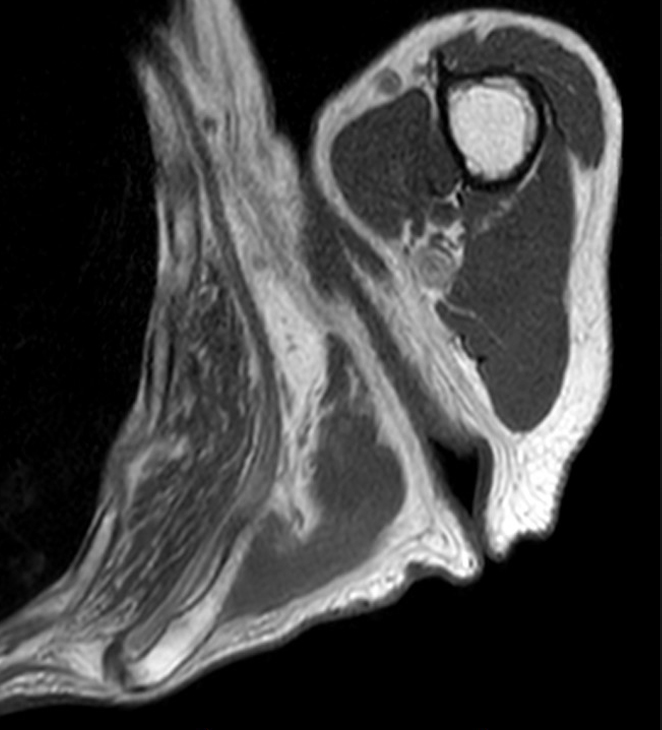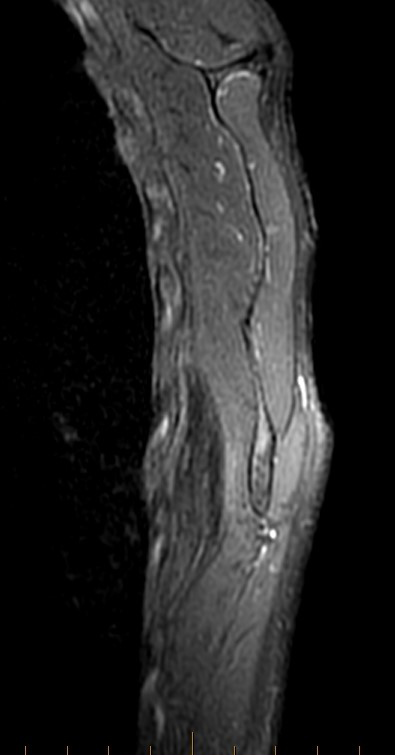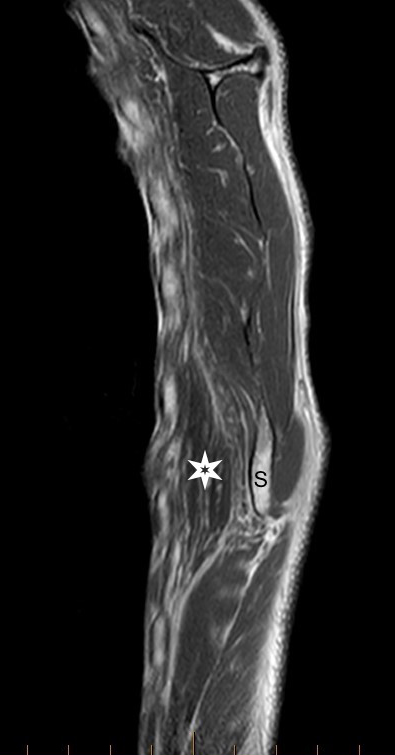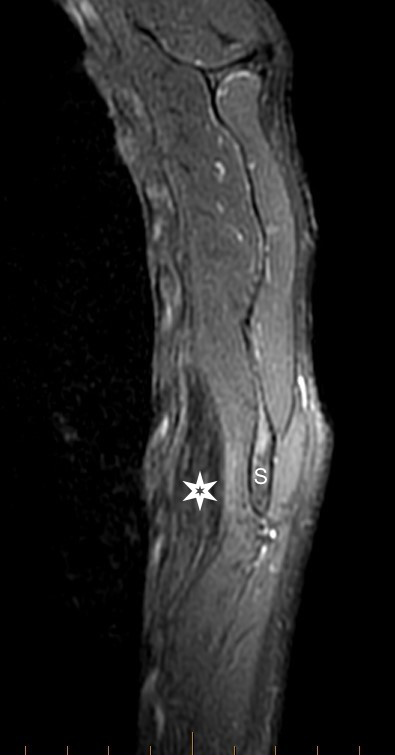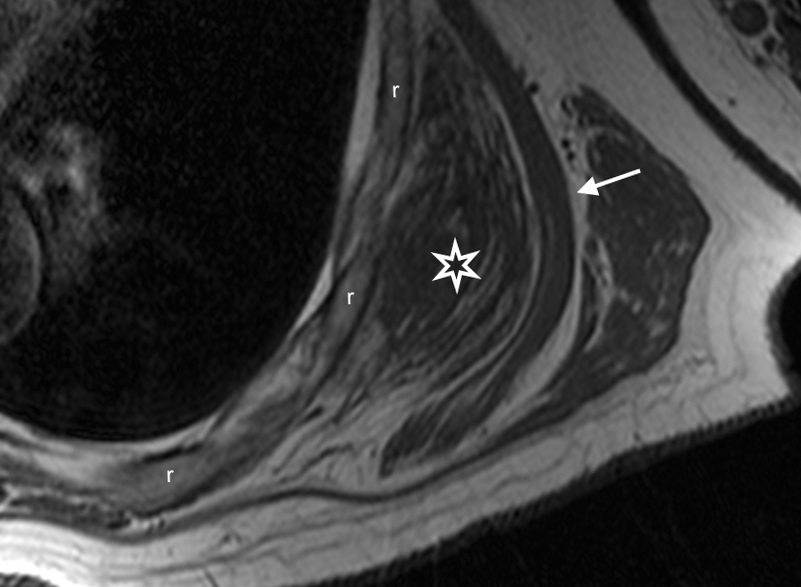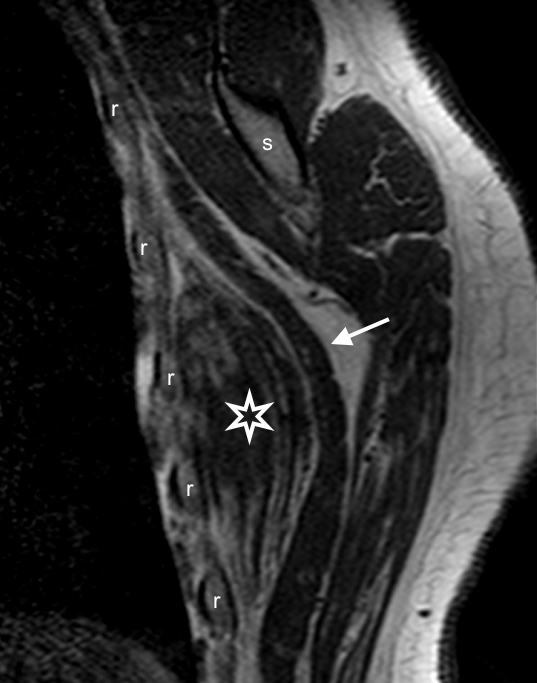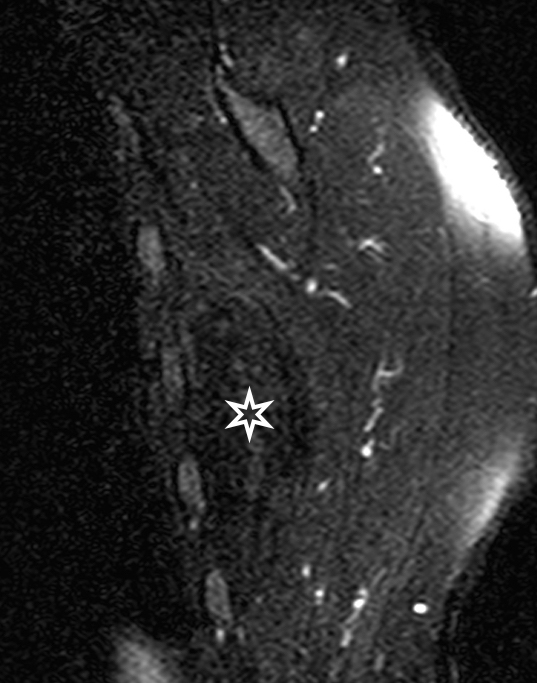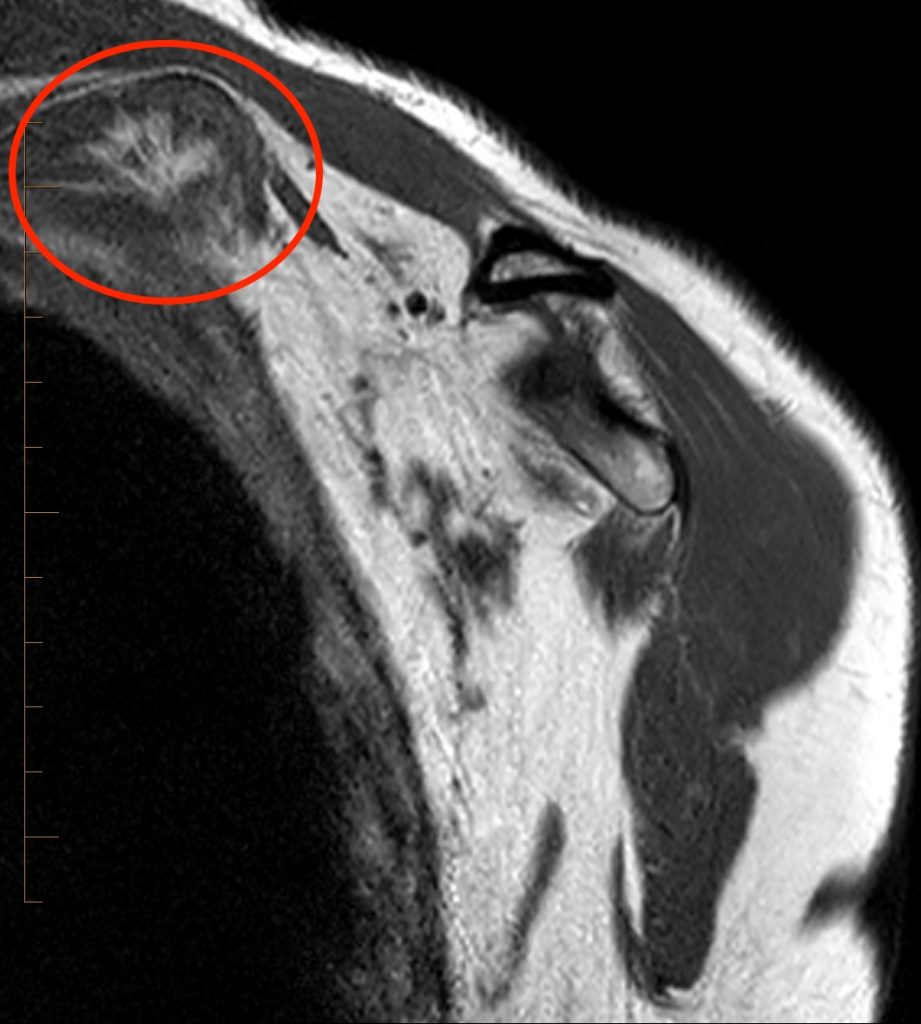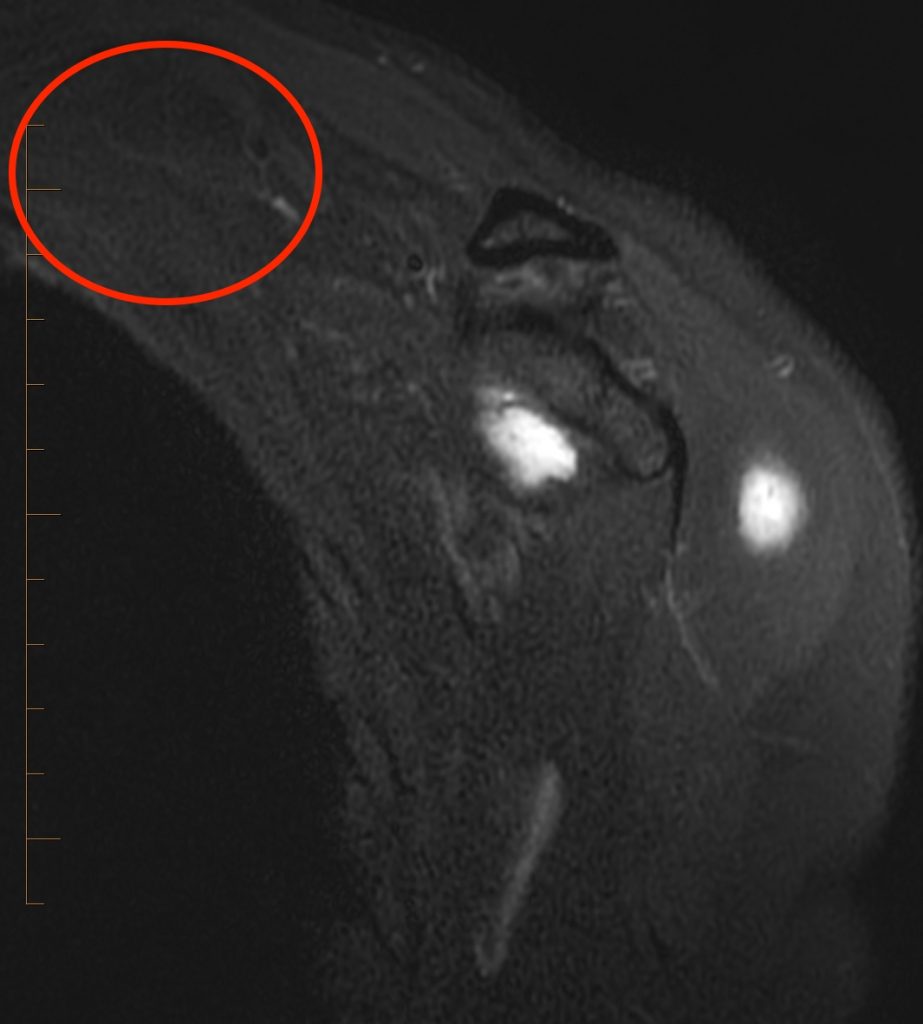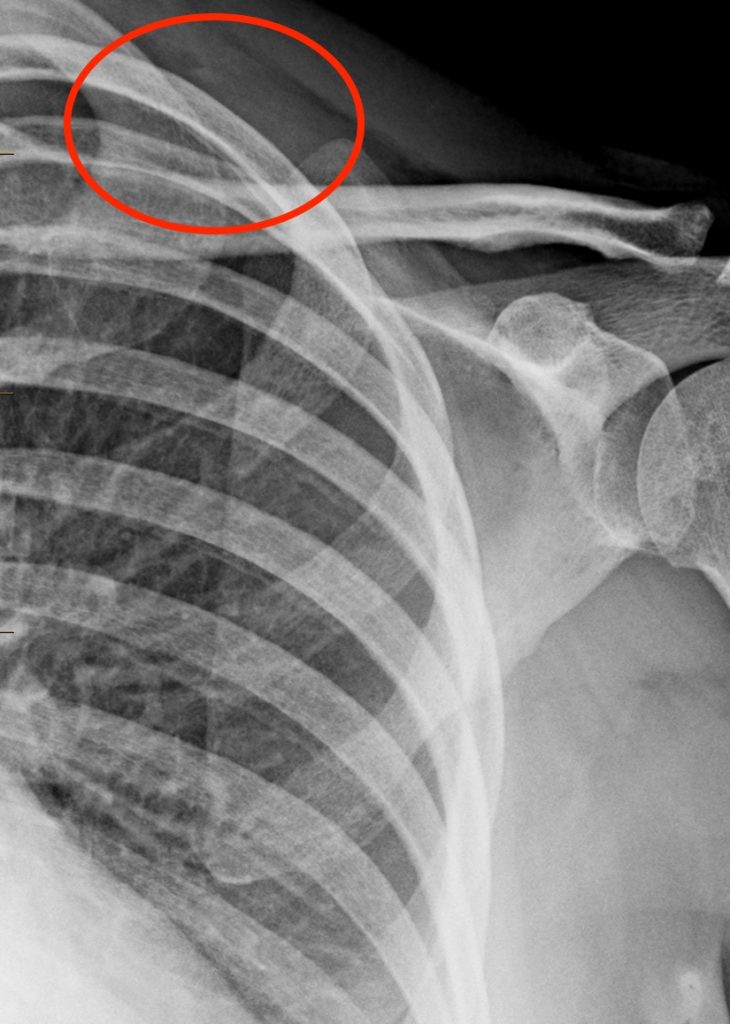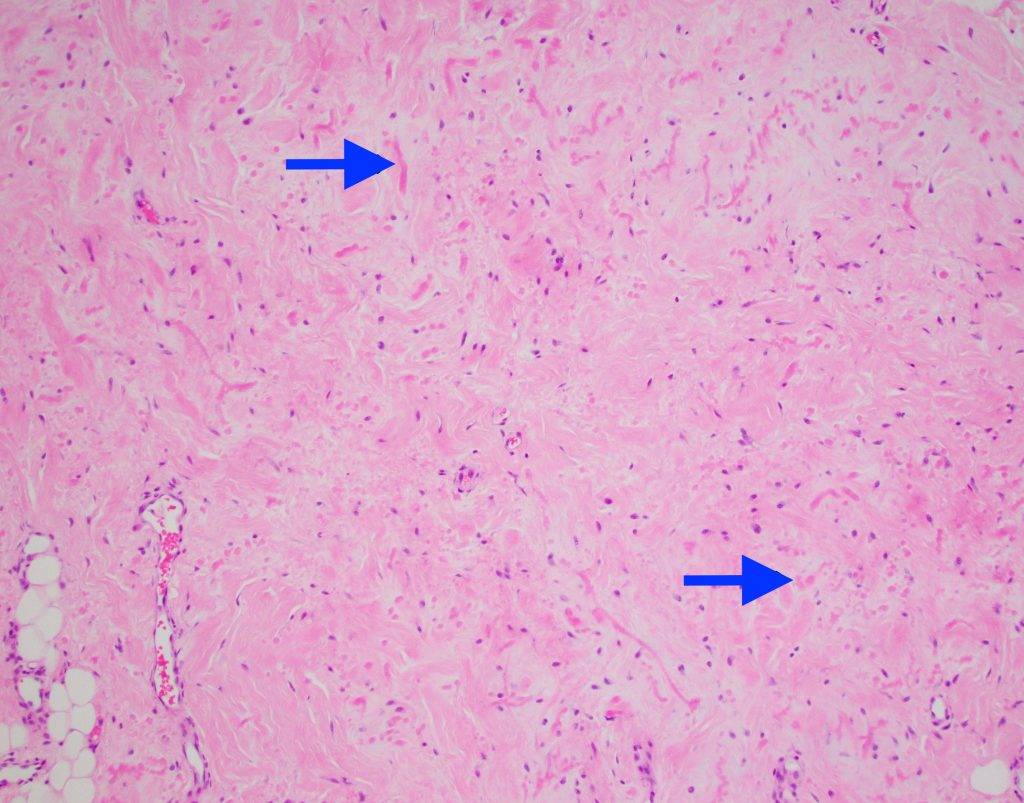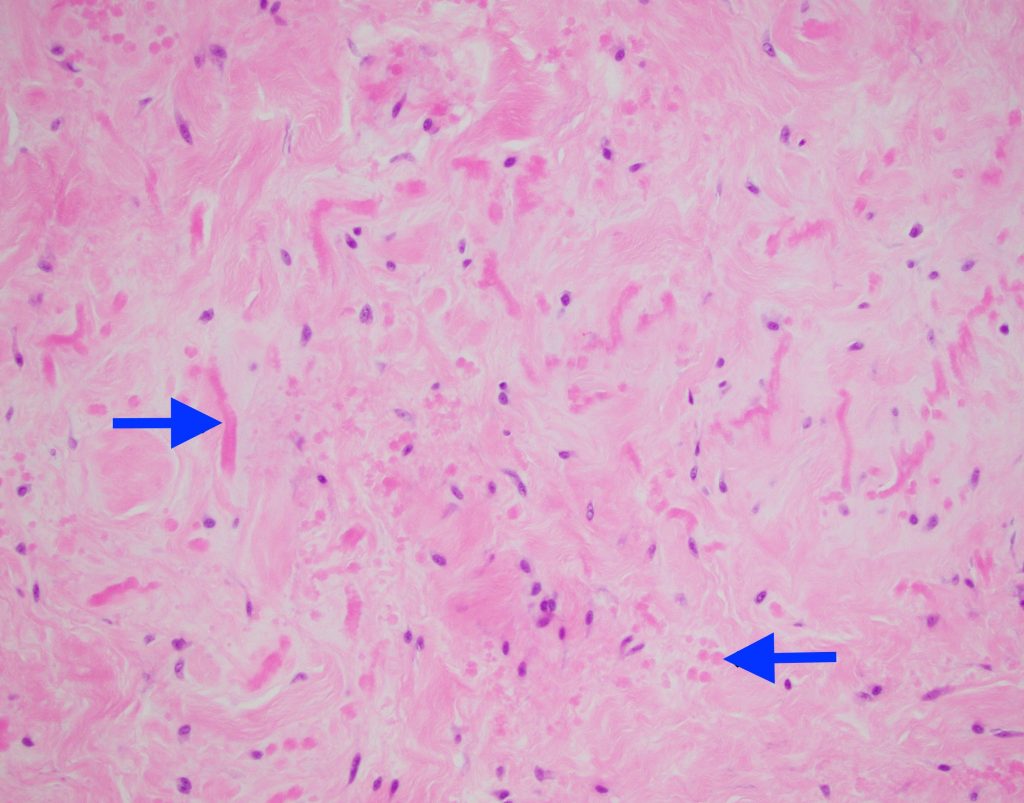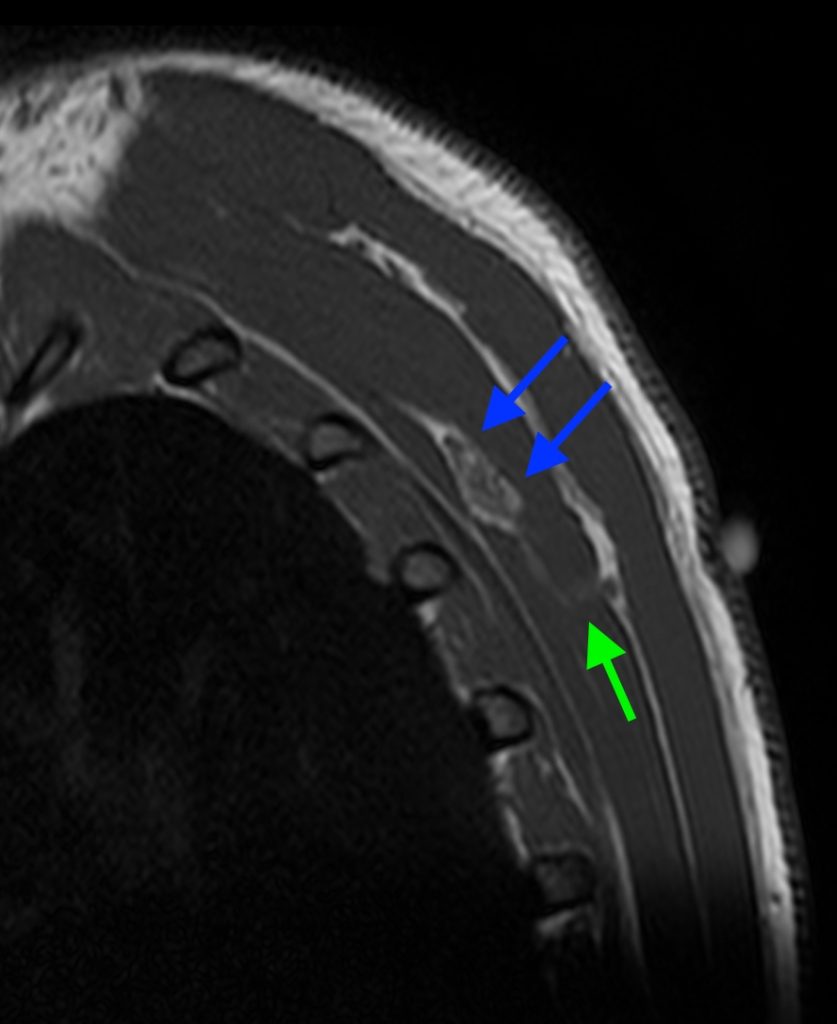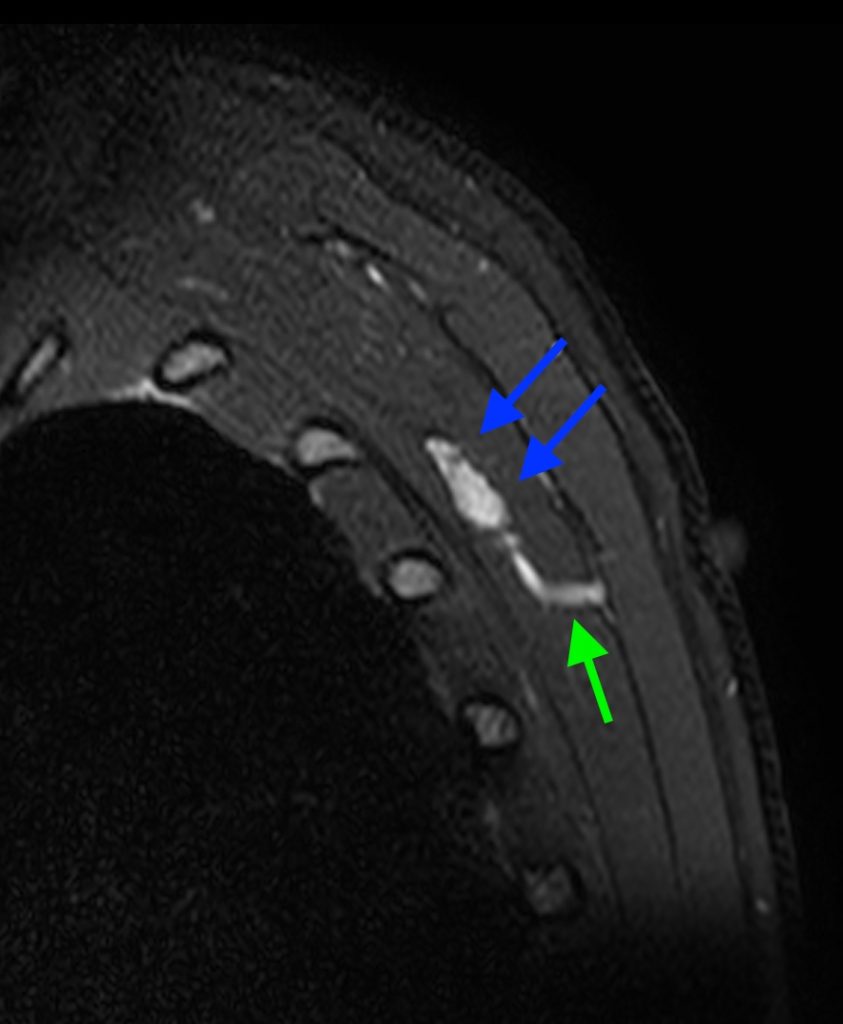Clinical History: A 79 year-old female noticed a painless mass along the inferior scapula, present for several months. Axial T1-weighted (1a), coronal T2-weighted (1b), sagittal T1-weighted (1c), and fat-suppressed sagittal T2-weighted (1d) images are provided. What are the findings? What is your diagnosis?
Findings
Figure 2:
Axial T1 (2a), coronal T2 (2b), sagittal T1 (2c), and fat-suppressed sagittal T2 weighted (2d) MR images demonstrate an ovoid mass (*) along the inferior margin of the scapula (S), deep to the serratus anterior muscle (arrow). The mass contains areas of striated increased T1 signal, consistent with bands of fat. Alternating bands of intermediate to low T1/T2 signal are also present, consistent with intermixed fibrous tissue.
Introduction
Elastofibroma dorsi (EFD) is an uncommon benign soft tissue tumor which most commonly occurs in the infrascapular region of elderly patients, typically arising between the rhomboid major and latissimus dorsi muscles, subjacent to the inferior angle of the scapula.1 This Web Clinic reviews the epidemiology, clinical presentation, imaging findings, pathology, differential diagnosis, and management of EFD.
Epidemiology
EFD was first described by Jarvi and Saxen in 1959 and reported in 1961 in the 12th Histopathology Scandinavian Congress.2,3 The benign slow growing soft tissue tumor represents approximately 1-2% of all chest wall primary tumors.3 Typically seen in older women, the mean age at diagnosis is 65-70 years old, with a female to male ratio of 5:1.1 EFD presents in the subscapular region in 99% of cases and more commonly on the right (presumably due to right hand dominance), with bilateral cases being reported 10-66% of the time.1 The exact cause of the lesion is unclear but proposed to be a reactive pseudotumor related to mechanical friction between the scapula and rib, more common in manual laborers.4 In less than 1% of cases, EFD has also been reported in other locations such as adjacent to the ischial tuberosity, olecranon, tricuspid valve, axilla, foot, mediastinum, stomach, greater omentum, inguinal region, orbit, and intraspinal space.5,6
Clinical Presentation
EFD is asymptomatic in 50% of patients,3,6 with symptoms dependent on the location and size of the lesion. If symptomatic, patients may report mild to moderate pain, discomfort or stiffness with shoulder abduction, scapular snapping, clicking, or clunking (figure 3).1,3,6 Neurological involvement may be rarely observed, suggesting cervical or brachial plexus pathology (figure 8).3 On physical exam, EFD typically presents as a well-defined sold mass, of variable size (4-12 cm), adherent to deep tissue layers but not the skin, and easily palpated along the thoracic wall.1,3 The scapula may mask the lesion, and pulling the patient’s arms forward with the body flexed forward 10-15 degrees may increase the conspicuity of the mass.1
Figure 3:
Clinical Presentation
Physical examination motion image (GIF) of a patient with elastofibroma dorsi demonstrates a mobile mass along the inferior margin of the scapula, with increased conspicuity and popping during shoulder flexion and abduction. Image courtesy of Dr. Jennifer Halpern and Dr. Ginger Holt, Vanderbilt University Medical Center, Nashville, TN.
MRI Findings
While EFD can be demonstrated with multiple modalities, MRI provides excellent soft tissue characterization and remains the modality of choice for evaluating this soft tissue mass.3,5,7 On MR imaging, EFD classically demonstrates a relatively well-defined unencapsulated soft tissue mass in the subscapular location, with alternating fibrous and fatty tissue.6,7 The fibrous tissue is isointense to skeletal muscle on T1 and T2 weighted sequences,6,8 while the fatty tissue demonstrates linear and curvilinear increased signal on T1 weighted sequences without fat suppression.6 Contrast is not particularly helpful, often demonstrating areas of mixed enhancement (figure 5).6,7
Figure 4:
Elastofibroma – Example B
Axial T1 (4a), fat-suppressed axial proton density (4b), sagittal T1 (4c) and fat-suppressed sagittal T2-weighted MR images demonstrate a well-marginated ovoid mass infrascapular mass (stars) deep to the serratus anterior (arrow). The mass contains areas of striated increased T1 signal intensity with alternating bands of intermediate to low signal.
Figure 5:
Elastofibroma – Example C
Axial T1 (5a), fat-suppressed T2 (5b), fat-suppressed T1 (5c) and post-contrast fat-suppressed T1-weighted (5d) images demonstrate an ovoid soft tissue fibrofatty mass along the inferior margin of the scapula, consistent with an elastofibroma. Mixed contrast enhancement is demonstrated on post contrast imaging (5d).
Figure 6:
Elastofibroma – Example D
Axial T1 (6a), fat-suppressed axial proton density (6b), coronal T1 (6c), fat-suppressed coronal T2 (6d), and sagittal T1-weighted (6e) MR images demonstrate a fairly well-circumscribed infrascapular fibrofatty soft tissue mass (stars), consistent with an elastofibroma.
Figure 7:
Elastofibroma – Example E
Coronal T1 (7a) and fat-suppressed coronal T2-weighted (7b) MR images demonstrate a fairly well circumscribed fibrofatty mass (red oval) interposed between the upper scapula and chest wall, consistent with an elastofibroma. On radiography (7c), the mass is subtle and non-calcified.
Figure 8:
Elastofibroma with suprascapular nerve denervation.
Coronal T1 (8a), coronal fat-suppressed T2 (8b), and axial fat-suppressed proton density-weighted (8c) MR images demonstrate an ovoid fibro-fatty mass (red circle), interposed between the upper ribs and superomedial margin of the scapula, consistent with an elastofibroma. The elastofibroma creates local mass effect upon the suprascapular nerve, resulting in selective denervation atrophy of the supraspinatus and infraspinatus muscles (arrows 8d, sagittal T2 weighted image).
Pathology
On gross specimen evaluation, EFD typically manifests as an unencapsulated, irregular, poorly defined fibroelastic mass, with a slight rubbery and elastic consistency.4–6 Thick fibrous bands are present, corresponding to areas of skeletal muscle signal intensity seen on MRI. Linear areas of golden yellow fatty tissue are also present, corresponding to the areas of linear increased T1 signal seen on MRI.
With histologic evaluation, EFD demonstrates eosinophilic collagen bundles, fragmented (linear, globular, and stellate) elastic fibers, and interspersed groupings of mature adipocytes.4–6,8 The tissue is predominantly hypocellular, containing fibrocytic and fibroplastic cells without atypia or mitotic activity5. The elastic fibrils become deeply stained with Verhoeff-van Gieson (elastic) stain, demonstrating a central dense core with serrated margins.4,8
Figure 9:
Elastofibroma Histology.
9a-b: Microscopic images of an elastofibroma with hematoxylin and eosin staining at 100x (a) and 200x (b) total magnification demonstrate pale pink collagen fibers with few spindled fibroblasts and focal fat. The numerous intermixed fragmented elastic fibers and globules (arrows) are darker and more eosinophilic than the background collagen. Images courtesy of Dr. Meghan Koch, Department of Pathology, Baylor University Medical Center, Dallas, Texas.
Differential Diagnosis
The differential diagnosis of an infra or periscapular soft tissue mass varies depending on the MRI signal characteristics. A soft tissue mass with increased T1 signal includes lesions containing fat or hemorrhage such as elastofibroma, lipoma, liposarcoma, hemangioma, hematoma, and intralesional hemorrhage.8 A soft tissue mass with signal characteristics similar to skeletal muscle includes lesions with decreased cellularity and abundant collagen such as desmoid, fibroma, neurofibroma, and malignant fibrous histiocytoma.4,8 Bone neoplasms of the scapula include osteochondroma, chondrosarcoma, or metastatic disease. Non-neoplastic lesions such scapulothoracic bursitis may also be of consideration.
Figure 10:
Lipoma.
Axial T1 (10a), axial fat-suppressed proton density (10b), sagittal T1 (10c) and coronal T1-weighted (10d) MR images demonstrate a well-circumscribed soft tissue mass (stars) along the posteroinferior margin of the scapula and latissimus dorsi muscle. The mass contains predominantly macroscopic fat and a few thin septations, consistent with a simple lipoma.
Figure 11:
Venous malformation (hemangioma).
Sagittal T1 (11a), sagittal fat-suppressed T2 (11b), axial T1 (11c), and axial fat-suppressed proton density-weighted (11d) images demonstrate an ovoid serpentine soft tissue lesion insinuating between the upper scapula and ribs containing areas of mixed increased T1 and T2 signal (blue arrows). A prominent adjacent vessel is also noted (green arrow), and the lesion is most consistent with a venous malformation.
Figure 12:
Intralesional Hemorrhage.
Axial T1 (12a), axial fat-suppressed proton density (12b), sagittal T1 (12c), and sagittal fat-suppressed proton density-weighted (12d) images demonstrate an ovoid subscapular mass, containing a rim of peripheral increased T1 and proton density signal. The patient was on coumadin and the areas of increased T1 signal are most consistent with intralesional hemorrhage.
Figure 13:
Scapular Osteochondroma.
Axial T1 (13a), axial fat-suppressed T2 (13b), and sagittal T2-weighted (13c) images demonstrate a circumscribed pedunculated mass arising from the anterior body of the scapula with contiguous cortical and cancellous bone, consistent with an osteochondroma (*). Areas of bright T2 signal are present along the margins of the osteochondroma near the chest wall, consistent with associated adventitial bursitis (arrows).
Figure 14:
Scapulothoracic Bursitis.
Axial fat-suppressed proton density (14a), sagittal T2 (14b), coronal T1 (14c) and fat-suppressed coronal T2-weighted (14d) images demonstrate an ovoid area of fluid signal along the inferior scapula (S) and ribs (r), consistent with scapulothoracic bursitis (arrows).
The imaging features of EFD are characteristic and different from most other soft tissue tumors, demonstrating entrapped fat within a predominantly fatty mass.8 Smaller EFDs may appear more homogeneous due to an earlier stage of development.6 A similar bilateral lesion virtually eliminates the possibility of malignancy and helps confirm the diagnosis of EFD4. Atypical features such as bone destruction or chest wall invasion should raise suspicion for a more aggressive or malignant lesion such as a sarcoma or metastatic lesion.6
Management
In an asymptomatic lesion with classic imaging findings, EFD is managed conservatively.1,6 Biopsy is reserved for cases with atypical MRI findings.3 FNA is not recommended due to the hypocellularity of EFD, and core or open biopsy is recommended to obtain adequate tissue samples.1
Complete surgical excision with marginal resection is recommended only for patients who have functional motion limitations, compressive symptoms, pain, or large (>5 cm) lesions.1,3 The post-surgical prognosis is excellent, with a very low recurrence rate seen only in cases of incomplete excision.1 No cases of malignant transformation have been reported.3,5
Summary
Elastofibroma dorsi is a benign soft tissue mass, typically presenting in an elderly female in the sub or periscapular region of the dominant-sided extremity. Bilateral lesions are not uncommon and help confirm the diagnosis. On MRI, EFD classically demonstrates a well-defined unencapsulated soft tissue mass with alternating fibrous and fatty tissue. No further imaging or treatment is indicated in a classic asymptomatic lesions. Biopsy or complete excision may be performed for atypical or symptomatic cases.
References
- Karakurt O, Kaplan T, Gunal N, et al. Elastofibroma dorsi management and outcomes: Review of 16 cases. Interact Cardiovasc Thorac Surg. 2014;18(2):197-201. doi:10.1093/icvts/ivt442 ↩
- Järvi OH, Saxén AE, Hopsu‐Havu VK, Wartiovaara JJ, Vaissalo VT. Elastofibroma—a degenerative pseudotumor. Cancer. 1969. doi:10.1002/1097-0142(196901)23:1<42::AID-CNCR2820230105>3.0.CO;2-# ↩
- Karrakchou B, Yaikoubi Y, Chairi MS, Jalil A. Elastofibroma dorsi: Case report and review of the literature. Pan Afr Med J. 2017;28:1-8. doi:10.11604/pamj.2017.28.34.13675 ↩
- Naylor MF, Nascimento AG, Sherrick AD, McLeod RA. Elastofibroma dorsi: Radiologic findings in 12 patients. Am J Roentgenol. 1996;167:683-687. doi:10.2214/ajr.167.3.8751681 ↩
- Daigeler A, Vogt PM, Busch K, et al. Elastofibroma dorsi – Differential diagnosis in chest wall tumours. World J Surg Oncol. 2007;5:1-8. doi:10.1186/1477-7819-5-15 ↩
- Ochsner JE, Brooks GN, Sewall SA, Agni R. Best cases from the AFIP: Elastofibroma dorsi. Radiographics. 2006;26(6):1873-1876. doi:10.1148/rg.266055184 ↩
- Clinckemaillie G, Larbi A, Omoumi P, Manelfe J, Dallaudière B. Bilateral elastofibroma dorsi: Typical CT and MRI features. J Belge Radiol – Belgisch Tijdschr voor Radiol. 2014;97:45. doi:10.5334/jbr-btr.12 ↩
- Kransdorf MJ, Meis JM, Montgomery E. Elastofibroma: MR and CT appearance with radiologic-pathologic correlation. Am J Roentgenol. 1992;159:575-579. doi:10.2214/ajr.159.3.1503030 ↩

